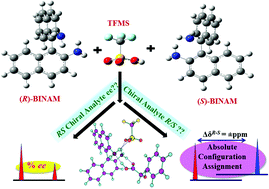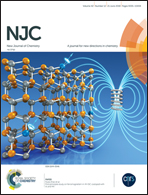A simple ternary ion-pair complexation protocol for testing the enantiopurity and the absolute configurational analysis of acid and ester derivatives†
Abstract
A simple ternary ion-pair complexation protocol has been developed for rapid testing of the enantiopurity and the assignment of absolute configurations of various acid and ester derivatives employing 1,1′-[binaphthalene]-2,2′-diamine (BINAM) as a novel chiral solvating agent (CSA) in the presence of trifluoromethanesulfonic acid (TFMS) as a third component. TFMS effectively enhances the ability of complexation between BINAM and the chiral analyte by stabilizing the ternary complex through strong hydrogen bonding interactions. In addition to testing of the enantiopurity, the systematic variation in the chemical shift positions of the distinctly identifiable peaks of the diastereomer complexes generated by using enantiopure (R)-BINAM and (S)-BINAM permitted the unambiguous assignment of the stereospecific configurations of different acid and ester derivatives. The protocol is superior to our earlier report where NOBIN with TFMS permitted only the absolute configurational assignment of hydroxy acids. The application of the protocol for the determination of enantiomeric contents of an asymmetric reaction has also been demonstrated.



 Please wait while we load your content...
Please wait while we load your content...